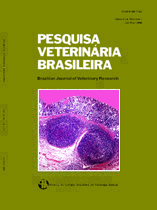 |
|
|
|
Year 2012 - Volume 32, Number 10
|

|
Influence of tail biting on weight gain, lesions and condemnations at slaughter of finishing pigs, 32(10):967-974
|
ABSTRACT.- Marques B.M.F.P.P., Bernardi M.L., Coelho C.F., Almeida M., Morales O.E., Mores T.J., Borowski S.M. & Barcellos D.E.S.N. 2012. Influence of tail biting on weight gain, lesions and condemnations at slaughter of finishing pigs. Pesquisa Veterinária Brasileira 32(10):967-974. Setor de Suínos, Faculdade de Veterinária, Universidade Federal do Rio Grande do Sul, Avenida Bento Gonçalves 9090, Porto Alegre, RS 91540-000, Brazil. E-mail: davidbarcellos@terra.com.br
The present study assessed the association of tail-biting lesions in finishing pigs with weight gain, occurrence of locomotion or respiratory disorders and abscesses during finishing period, and carcass condemnation at slaughter. The study was carried out on 4 different farms. For each animal with a tail biting lesion, two control pigs were selected. The total number of animals in the study was 312, with 104 of them being tail-bitten. Tail lesions were classified according to the degree of severity into four scores: score 0 –normal tail withou lesion; score 1-3 - increasing lesion severity, and score 4 - healed lesions. Overall, the occurrence of severe tail lesions (score 3) varied from 55 to 73% of tail-bitten pigs among farms. On all farms, healing of tail lesions was observed in 95% to 100% of the animals at the evaluation performed within 41-43 days after the commencement of the study. In two out of the four evaluated farms, pigs with score of 3 showed lower weight gain (P<0.05) compared with score 0 pigs. Before slaughter, the occurrence of locomotion problems and nodules/abscesses was associated (P<0.05) with the presence of tail-biting lesions. At slaughter, tail-biting lesions were associated (P<0.05) with the presence of abscesses, lung lesions (pleuritis and embolic pneumonia) or arthritis in carcasses. Carcass condemnation was associated with the presence of tail-biting lesions (P<0.05). Overall, carcass condemnation rate was 21.4%, of which animals with tail-biting lesions accounted for 66.7% of condemnations. Among the animals diagnosed with cannibalism at farm level, only two had not healed their lesions at slaughter. The fact that there were a lot of carcass condemnations, despite the fact that tail-bitten animals had no more active lesions, suggests that different situations may be observed between the field and slaughter, reinforcing the need to analyze pigs both at farm and slaughter to allow proper assessment of losses related to tail biting. Collectively, the observations of the present study show that complications associated with tail-biting found in slaughterhouses are probably underestimating field prevalence. |
| |
|
|
| |
|
 |